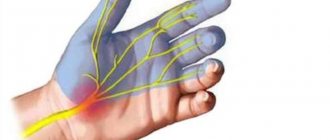Peripheral neuropathy (nerve neuropathy) refers to damage to the peripheral nervous system, a vast system of communication nerve fibers that carries information from the brain and spinal cord to any part of the body. Peripheral nerves also send sensory information back to the brain and spinal cord, informing about the presence of tissue effects (cold or burn). When the peripheral nervous system is damaged, these vital connections are disrupted.
This can be compared to a communication breakdown at a telephone exchange, when the connection between the station and the subscribers is disrupted (similar interruptions in communication occur between the brain and parts of the body). Because each peripheral nerve has a highly specialized function in a specific part of the body, when a nerve is damaged, symptoms may vary. For some, this may include numbness, tingling, excessive sensitivity to touch (paresthesia), or muscle weakness. Others may have more severe symptoms, including severe pain (especially at night), muscle wasting, paralysis, or glandular tissue or organ dysfunction. People may experience an inability to digest food normally, maintain normal blood pressure, sweating, and reproductive problems. In the most severe cases, there may be respiratory dysfunction or organ failure. In some forms of neuropathy, only one nerve is damaged, and this damage is called mononeuropathies. When a large number of nerves affecting the limbs are affected, such damage is called polyneuropathy. Sometimes two or more separate nerves in certain areas of the body are affected, this is called multifocal mononeuritis. In acute neuropathies, such as Guillain-Barré syndrome, symptoms appear suddenly, progress rapidly, and recovery of function occurs slowly as nerve fiber damage occurs. In chronic forms of neuropathy, symptoms appear gradually and progress slowly. In some patients, periods of remission are followed by periods of exacerbation. For others, the condition may reach a plateau in which symptoms remain unchanged for many months or years. Some chronic neuropathies progress over time, but very few forms are fatal unless there are complications associated with other diseases. Often, neuropathy is a symptom of another disease.
In the most common forms of polyneuropathy, the nerve fibers furthest from the brain begin to dysfunction first. Pain and other symptoms often appear symmetrically, such as in both legs, followed by gradual progression in both legs. Sometimes the fingers and arms are affected, progressing higher towards the middle of the body. Many patients with diabetic neuropathy experience this type of progression and nerve damage.
Types of damage
Damage to the nerves of the hand is represented by the following groups.
- Complete rupture of a nerve is called neurotmesis. Surgical treatment is indicated. Recovery occurs over months or years depending on the severity of the damage.
- Partial rupture accompanied by various disorders - neuropraxia - occurs with closed injuries. A condition with preserved nerve sensitivity, when the lack of conduction is temporary.
- Neuropathy is a disorder resulting from a fracture, bruise or cut in the hand area.
- A pinched nerve occurs when the patient cannot bend the wrist. The little finger is completely immobilized, the ring finger is partially immobilized, the thumb moves with difficulty. The pain radiates to the little finger.
Symptoms and causes
Symptoms are related to the type of nerve damaged and may appear over a period of days, weeks, or years. Muscle weakness is the most common symptom of motor nerve damage. Other symptoms may include painful cramps and fasciculations (muscle twitching of the subcutaneous muscles), muscle atrophy, bone degeneration, and changes in the skin, hair, and nails. These general degenerative changes may also result from damage to the sensory fiber or autonomic fiber bundle.
Sensory nerve damage causes a wider range of symptoms because sensory nerves have a whole group of highly specialized functions. Large sensory fibers are surrounded by a myelin sheath and record vibration, tactile sensations and proprioception. Damage to large sensory fibers reduces the ability to sense vibration and touch, resulting in numbness, especially in the arms and legs. People may feel the sensation of wearing gloves or stockings. Many patients cannot distinguish the size of an object or its shape by touch. This damage to sensory fibers can contribute to loss of reflexes (as does motor nerve damage). Loss of proprioception (the sense of the body's position in space) makes it difficult to coordinate complex movements or balance with eyes closed. Neuropathic pain is difficult to treat and can have a serious impact on your emotional well-being and overall quality of life. Neuropathic pain often worsens at night, severely disrupting sleep, leading to further emotional distress.
Smaller sensory fibers without myelin sheaths transmit pain and temperature sensations. Damage to these fibers can impair the ability to feel pain or changes in temperature. People may not be able to feel the cut or the wound festering. Other patients may not feel the pain that is a warning sign during a life-threatening heart attack or other acute condition. Loss of pain sensation is a particularly serious problem in patients with diabetes, contributing to the high rate of lower extremity amputations in this population. Pain receptors in the skin may also become hypersensitive, so that patients experience severe pain (allodynia) from stimuli that are normally painless (for example, rubbing a cloth over the skin or lightly touching it). Symptoms of damage to bundles of autonomic nerve fibers are varied and depend on the organ innervated by them. Autonomic nerve dysfunction can be life-threatening and sometimes requires emergency medical attention, especially when breathing or heart rate is affected. Common symptoms of damage to the autonomic nerve fiber bundles include impaired sweating, which is necessary when overheated, impaired urinary function which can lead to urinary incontinence or bladder infections; and impaired control of the muscles responsible for contracting blood vessels, which can affect the maintenance of normal blood pressure. Loss of control of blood pressure can cause dizziness, nausea, or even fainting when a person suddenly falls when changing body position (a condition known as postural or orthostatic hypotension). Gastrointestinal symptoms often accompany autonomic neuropathy. The nerves that control contractions of the intestinal muscles malfunction, leading to diarrhea and constipation. Many patients also have problems with swallowing when the corresponding nerve fibers are damaged.
Peripheral neuropathy can be either inherited or acquired. Causes of acquired peripheral neuropathy include: nerve damage (trauma), tumors, intoxication, autoimmune reactions, nutritional disorders (vitamin deficiency), chronic alcoholism, and vascular and metabolic disorders. Acquired peripheral neuropathies are grouped into three broad categories: those caused by systemic disease, those caused by trauma from external factors, and those caused by infections or autoimmune disorders that damage nerve tissue. An example of acquired peripheral neuropathy is trigeminal neuralgia, in which damage to the trigeminal nerve causes episodic attacks of excruciating pain on one side of the face. In some cases, the cause is the consequences of a viral infection, as well as pressure on the nerve from tumor tissue or an enlarged blood vessel. In many cases, a specific cause cannot be identified. Doctors usually diagnose idiopathic neuropathy in such cases.
Traumatic injury is the most common cause of nerve damage. Injury or household trauma from car accidents, falls, or sports-related injuries can lead to nerve fraying, nerve compression, stretching, or complete separation from the spinal cord. Even minor injuries can also cause serious nerve damage. Broken or dislocated bones can put damaging pressure on nearby nerves, and nerve root compression can also occur with herniated discs.
Systemic diseases are conditions that affect the entire body and often cause peripheral neuropathy. These conditions may include: metabolic and endocrine disorders. Nerve tissue is very sensitive to changes in tissue metabolism and regeneration processes, which can change with systemic diseases. Diabetes mellitus, characterized by chronically high blood glucose levels, is a leading cause of peripheral neuropathy in some countries (USA). Approximately 60 to 70% of patients with diabetes have both moderate and severe forms of nervous system damage. Kidney disease can lead to excess toxic substances in the blood, which can seriously damage nerve tissue. Most patients requiring dialysis due to renal failure develop polyneuropathy. Some liver diseases also lead to neuropathies as a result of metabolic disorders.
Hormonal imbalances can alter normal metabolic processes and cause neuropathies. For example, a lack of thyroid hormones slows metabolism, leading to fluid retention and tissue swelling, which can put pressure on peripheral nerves. Excess growth hormone production can lead to acromegaly, a condition characterized by abnormal enlargement of many parts of the skeleton, including joints. The nerves supplying these altered joints are often damaged as well.
Vitamin deficiencies and chronic alcoholism can cause irreversible damage to nerve tissue. Vitamins. Vitamins E, B1, B6, B12, and niacin are very important for normal nerve function. Thiamine deficiency is particularly common in people with chronic alcoholism because these people have an impaired dietary intake of thiamine. Thiamine deficiency can cause quite painful neuropathy of the limbs. Some researchers believe that excessive alcohol consumption may, in itself, contribute to direct nerve damage, called alcoholic neuropathy. Vascular and blood diseases can reduce oxygen delivery to peripheral nerves and quickly lead to severe damage or death of nerve tissue (for example, acute brain hypoxia leads to stroke). Diabetes often leads to a narrowing of the blood vessel. Various forms of vasculitis often lead to thickening of the vessel wall and a decrease in the diameter of the vessels due to scar tissue. This category of nerve damage, in which isolated nerves in different areas are damaged, is called multifocal mononeuropathy.
Connective tissue diseases and chronic inflammation can cause direct or indirect nerve damage. When the tissue layers surrounding the nerves are in a prolonged inflammatory process, the inflammation can directly affect the nerve fibers. Chronic inflammation also leads to progressive destruction of connective tissue, exposing nerve fibers to greater risk of compression and infection. When joints become inflamed, they can swell and involve nerves, causing pain.
Cancer and benign tumors can grow and have a destructive effect on the nerves. Tumors can also form directly from nerve tissue cells. Quite often, polyneuropathy is associated with neurofibromatosis, a genetic disease in which multiple benign tumors form from nerve tissue. Neuroma formation may be one element of regional pain syndrome or sympathetic reflex dystrophy syndrome, which can be caused by traumatic causes or surgical trauma. Paraneoplastic syndrome, a group of rare degenerative disorders that are caused by a person's immune system's response to cancer, can also indirectly cause multiple nerve damage. Repeated stress exposure often leads to compression neuropathies. Cumulative damage can occur due to repeated excessive movements that require bending any group of joints for an extended period of time. As a result of such movements, inflammation and swelling of the tendons and muscles can occur, which can lead to narrowing of the channels through which some nerves pass. Such damage is not uncommon during pregnancy, likely because weight gain and fluid retention also narrow the nerve canals.
Toxic substances can also cause damage to peripheral nerves. People who are exposed to heavy metals (arsenic, lead, mercury, thallium), industrial toxins, or environmental toxins often develop neuropathies. Certain cancer drugs, anticonvulsants, antivirals, and antibiotics have side effects that may include peripheral nerve damage, which is sometimes a contraindication for long-term use.
Infections and autoimmune disorders can cause peripheral neuropathy. Viruses and bacteria that can affect nerve tissue include herpes zoster, Epstein-Barr virus, cytomegaly virus, and other types of herpes viruses. These viruses selectively damage sensory nerves, causing paroxysmal, sharp pain. Postherpetic neuralgia often occurs after an episode of shingles and can be very painful.
The human immunodeficiency virus (HIV) also causes significant damage in the central and peripheral nervous system. The virus can cause several different forms of neuropathy, each of which is clearly associated with a specific stage of immunodeficiency. Rapidly progressive, painful polyneuropathy involving the arms and legs is often the first clinical symptom of HIV infection.
Lyme disease, diphtheria, and leprosy are bacterial diseases characterized by extensive damage to peripheral nerves. Diphtheria and leprosy are now quite rare, but Lyme disease has become more common. Lyme disease can cause a wide range of neuropathic disorders, including the rapid development of a painful polyneuropathy, often within weeks of initial infection during a tick bite.
Viral and bacterial infections can also cause secondary nerve damage, causing autoimmune disorders in which the immune system attacks its own tissues. Autoimmune processes typically cause destruction of the myelin sheaths of nerves or axons (nerve fibers).
Some neuropathies are caused by inflammation resulting from the immune system's response rather than from direct damage from infectious agents. Inflammatory neuropathies can develop quickly or slowly, and chronic forms can have periods of both remission and relapse. Acute inflammatory demyelinating polyneuropathy, known as Guillain-Barré syndrome, can damage motor, sensory, and autonomic nerve fiber bundles. Most people recover after developing this syndrome, but sometimes severe forms are life-threatening, although severe cases can be life-threatening. Multifocal motor neuropathy is a form of inflammatory neuropathy that involves damage exclusively to motor neurons (can be either acute or chronic).
Hereditary forms of peripheral neuropathy are caused by congenital errors in the genetic code or mutations. Some genetic abnormalities lead to mild neuropathies with symptoms that begin in adolescence and then subside over time. More severe hereditary neuropathies often appear in infancy or childhood. The most common hereditary neuropathy is Charot-Marie-Touss disease. These neuropathies occur due to a disorder in the genes responsible for the formation of neurons or myelin sheaths. Signs of typical Charlotte-Marie-Tousse disease include extreme weakening of the leg and foot muscles, gait disturbance, disappearance of tendon reflexes, and numbness in the lower extremities.
Diagnostics
To make a diagnosis, examination using palpation and a series of tests is important.
- Discriminative two-point test - the sensitivity of the branches is checked in turn and the reaction is compared.
- The sensory function of the radial nerve is checked by a discrimination test at two points and pricking the folds of the thumb.
- Motor branches are tested by joint extension.
- The sensitivity of the ulnar nerve is determined on the little finger; to control motor capabilities, the patient spreads his fingers with force.
- Additional tests to analyze ulnar nerve function include ring finger flexion and thumb adduction.
- Motor function of the median nerve is tested by resisting flexion of the wrist and index finger.
- A visual test of the sensitivity of the median nerve is a discrimination test with an attachment in the palm.
Statistics
Neuropathies are most often diagnosed among patients with diabetes mellitus - they develop in 60% of patients in this group.
Up to 15% of adults suffer from various manifestations of neuropathy; in reality, the numbers are supposedly higher, since most patients with initial manifestations do not see a doctor.
Between 20 and 45% of HIV-infected patients suffer from this disorder.
In 30% of patients undergoing chemotherapy for cancer, peripheral nerve damage is observed.
The prevalence of alcoholic neuropathy in different countries ranges from 10-12% to 45-52% among people with various stages of alcohol dependence. It is worth noting that neurophysiological studies reveal initial manifestations of neuropathy in almost 90% of alcoholics.
When is surgery indicated?
- Impaired sensitivity and movement function.
- Tumors.
- Painful neuromas.
- Compression by scars.
- Damage due to trauma.
- Pain syndrome.
Taking into account the nature of the injury, the method of surgical treatment is selected:
- Excision of scar formations – neurolysis;
- Connecting the nerve sheath and applying a special suture;
- Carrying out plastic surgery of nervous tissue.
During surgical treatment, microsurgical techniques are used to make the comparison as accurate as possible.
Rehabilitation
The recovery period takes at least six months. First, touch is restored, then sensitivity when touching two points. For recovery, it is important to recognize objects by touch.
Principles of successful rehabilitation:
- Early intervention;
- Reducing the risk of complications;
- Ensuring healing;
- Restoring the functions of the nerve of the hand;
- Using a multi-stakeholder approach.
Restoration of the hand nerve is carried out at the clinic of the Central Clinical Hospital of the Russian Academy of Sciences, in the department of hand microsurgery. Everything is available here for effective treatment of a nerve rupture in the arm - experienced, highly qualified surgeons work, the most modern microsurgical equipment is used, and the staff is caring.
Registration for a consultation is carried out on the website. You can get the information you are interested in and find out the price of treatment by calling the number provided.
Recovery forecast
Rehabilitation of patients after nerve damage from any type of surgery may require restoration of lost functions. Immediately after the operation, there is pain, which is relieved with painkillers. The sutures are removed after 7-10 days. The surgical wound is treated every day. If the intervention was performed on the limbs, then a plaster cast is indicated to immobilize and prevent the sutures from coming apart. To speed up recovery, physiotherapy, massage, and exercise therapy are indicated.
The speed of healing is affected by:
- patient’s age – the younger the person, the faster the regeneration processes;
- volume and type of injury;
- purpose and size of nerve fiber;
- time from the moment of injury to surgical intervention - this interval should be no more than 1 year, otherwise it will be impossible to restore functions;
- individual characteristics of the body;
- accompanying pathologies.
Healing is better with cut wounds when the ends of the cut fiber have an even cut and are located close to each other. If a fiber close to the neuron is damaged, healing will be slower. Bundles that perform only one function heal better than nerve fibers that are part of a trunk with different purposes.






